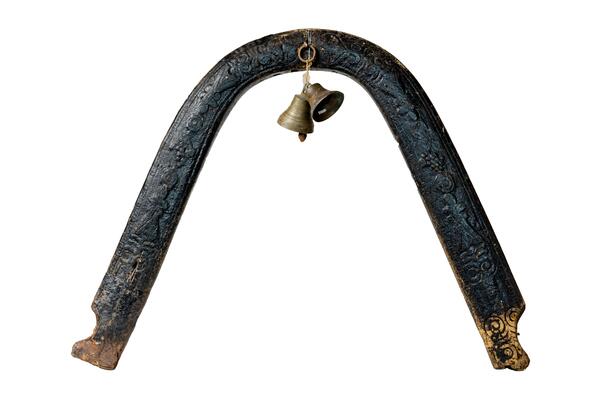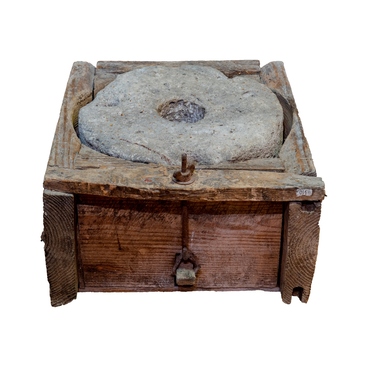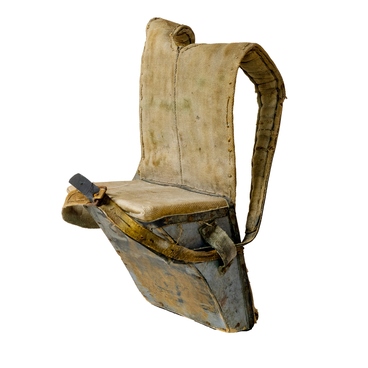The shaft bow is one of the elements of a horse harness. It is believed that the Finns and the Karelians were the first ones who started to use it in the 12–13th centuries. And only later this element was adopted by the Russians. The shaft bow was used to harness the horses to a sleigh or a cart. The thills were attached to its ends.
This detail of a harness looked like a carrying pole. Its bend narrowed in the center, but the edges diverged widely. It was necessary to make such a shape as a way to avoid a thill hitting a horse if the cart falls into a hole or goes over bumps. Moreover, a shaft bow helped to distribute load and absorb the landing shock.
The dimensions of this detail depended on the size of a horse and a cart. Also, there were some differences between the shaft bows for a single harness and a troika (team of three horses). If three horses carried a sleigh or a cart, then only one of them was under a shaft bow. That horse specified direction. It was called a leading or central horse. The other two horses were harnessed on both sides of thills and were called trace horses.
The peasants made the details of a horse harness themselves or delegated this work to specially trained craftsmen. They chose special wood for shaft bows. Bird cherry, filbert tree, or white willow were used to make lighter and more flexible workpieces suitable for small horses and carts. Massive shaft bows were made of oak and elm and were used for draft horses because they were durable and often inherited by several generations.
To bend a wooden workpiece, it was steamed in a hot bathhouse for a long time. As long as wood remained wet, it could be shaped into a necessary form. As usual, human strength was not enough to do it. That is why shaft bows were bent with the help of special machines. After that procedure, the wood was dried. This process took 1–2 months. A finished shaft bow was often decorated with painting or carving. People believed that it would scare evil spirits and bring good luck upon the road.
The shaft bow displayed at the collection of MBI “Nizhnevartovsk Museum of Local History named after T. D. Shuvayev” was made of a single piece of wood. Then it was painted black and covered with carvings on both sides. At its ends, there are deepenings used to attach thills.
This detail of a harness looked like a carrying pole. Its bend narrowed in the center, but the edges diverged widely. It was necessary to make such a shape as a way to avoid a thill hitting a horse if the cart falls into a hole or goes over bumps. Moreover, a shaft bow helped to distribute load and absorb the landing shock.
The dimensions of this detail depended on the size of a horse and a cart. Also, there were some differences between the shaft bows for a single harness and a troika (team of three horses). If three horses carried a sleigh or a cart, then only one of them was under a shaft bow. That horse specified direction. It was called a leading or central horse. The other two horses were harnessed on both sides of thills and were called trace horses.
The peasants made the details of a horse harness themselves or delegated this work to specially trained craftsmen. They chose special wood for shaft bows. Bird cherry, filbert tree, or white willow were used to make lighter and more flexible workpieces suitable for small horses and carts. Massive shaft bows were made of oak and elm and were used for draft horses because they were durable and often inherited by several generations.
To bend a wooden workpiece, it was steamed in a hot bathhouse for a long time. As long as wood remained wet, it could be shaped into a necessary form. As usual, human strength was not enough to do it. That is why shaft bows were bent with the help of special machines. After that procedure, the wood was dried. This process took 1–2 months. A finished shaft bow was often decorated with painting or carving. People believed that it would scare evil spirits and bring good luck upon the road.
The shaft bow displayed at the collection of MBI “Nizhnevartovsk Museum of Local History named after T. D. Shuvayev” was made of a single piece of wood. Then it was painted black and covered with carvings on both sides. At its ends, there are deepenings used to attach thills.



